Papers by Lamberto Tronchin
The Teatro Bibiena, known as the Scientific theatre in Mantua, is regarded as the most accomplish... more The Teatro Bibiena, known as the Scientific theatre in Mantua, is regarded as the most accomplished example of Rococo theatre construction, inspiring the authors to investigate its unique acoustic characteristics. An acoustic survey was carried out of the stall and some selected boxes according to the requirements of ISO 3382-1 standards. The results show that Mantua's Teatro Bibiena, unlike most Italian theatres, is more suited to musical performance than speech. The Italian opera house is a typical and precious architectural form, and scholars and scientists are responsible for highlighting the worth of cultural heritage. However, as an intangible cultural heritage, acoustics is intrinsically challenging to maintain and readily disregarded. Therefore, its recording, exploration, and transmission should be given equal weight to the historic theatre building itself.

Acoustics
Many acoustic studies have been carried out in the Italian theatres built during the 17th and 18t... more Many acoustic studies have been carried out in the Italian theatres built during the 17th and 18th centuries. Along with the development of technology, acoustic measurements become increasingly more accurate, able to capture the faithful acoustic conditions of these cultural heritage buildings that are considered icons for representing the house of sound. Although considered controversial for their innovative geometry and shape, the plan layouts proposed by the architect Antonio Galli Bibiena for the theatres placed in Bologna and Mantua were remarkable and appreciated by the audience given the florid artistical program run over the seasons. Site were undertaken in order to analyse the acoustic response of the main halls. From the recorded impulse response, both monoaural and binaural acoustic parameters were compared between the two theatres, where the analysis separately considered the stalls and balconies. The historical background of the selected theatres was detailed to underst...
Applied sciences, Feb 24, 2023
This article is an open access article distributed under the terms and conditions of the Creative... more This article is an open access article distributed under the terms and conditions of the Creative Commons Attribution (CC BY

The Journal of the Acoustical Society of America
Throughout history, many buildings of significant cultural value have been lost due to natural di... more Throughout history, many buildings of significant cultural value have been lost due to natural disasters (e.g., earthquakes, volcanic eruptions, subsidence, etc.) as well as other human causes (e.g., fire, war destruction, etc.). The Tajo Opera theatre was hit by an earthquake that led to the collapse of the entire structure eight months after it was built. This paper deals with the revival of the acoustic characteristics of one of the masterpieces of the architect Giovanni Carlo Sicinio Galli Bibiena. The realization of a three-dimensional (3D) model that faithfully reproduces the architectural features of the Royal Tajo Opera theatre of Lisbon allows the authors to perform acoustic simulations that reveal the sound field representing the environment perceived by the audience during artistic performances in Lisbon in 1755. In addition, the simulated results have been compared with the values of the Teatro Comunale of Bologna, which has a similar bell-shaped plan layout and has alre...
Canadian Acoustics, Apr 21, 2021
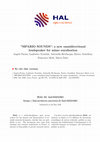
SIPARIO is a project recently funded by the Italian region Emilia Romagna. It aims to virtually r... more SIPARIO is a project recently funded by the Italian region Emilia Romagna. It aims to virtually reconstruct both 3D audio and 360° video of real performances by making recordings and undertaking acoustic measurements inside historical theatres and concert halls spread all over the Europe. One of the most relevant topics of this project is the development of a new spherical sound source, equipped with 32 individually-controlled loudspeakers [1], designed for measuring acoustic characteristics of these performing arts places. This loudspeaker array is capable of simulating the directivity of any dynamic sound source. The loudspeaker can work also like a traditional omnidirectional sound source for measuring standard acoustical parameters, hence it can be used in room acoustics tests in accordance with ISO3382 standard. Finally, it can create super-directive beams of various shapes, with arbitrary directivity patterns such as spherical harmonics (High Order Ambisonics) or cardioids (Spatial PCM Sampling). The Exponential Sine Sweep (ESS) signal has been employed in order to measure the room impulse response (RIR). It is also possible to employ a Multiple Input Multiple Output (MIMO) approach [2] by feeding sequentially the ESS signal to each transducer of the loudspeaker array, while a spherical microphone array is employed for recording. In this paper it is explained how to compute the matrix of FIR filters necessary to process such a MIMO RIR, and to synthesize arbitrary polar patterns for both source and receiver. Moreover, future developments of the new sound source are briefly described in Section 7, including the applications for the specific project.

The acoustic design of sound quality in Italian-style theatres and opera houses normally included... more The acoustic design of sound quality in Italian-style theatres and opera houses normally included the study of the acoustic absorptions of tissues in the main hall, the measurements in reverberant room of sound absorption of seats, the acoustic design of the Orchestra pit, which could be equipped with several acoustic panels. Nevertheless, no particular care is normally devoted to solving the effect of focalisation that often occurs in these special buildings. The focalisation in these theatres could compromise the overall acoustic quality and for this reason should be considered and avoided. During this plenary lecture, a short overview about the meaning of focalisation and its presence in the theatres will be presented. After some recalls about the theory of scattering and diffusion and its measurements, some examples of acoustic design of diffusing panels will be introduced. Moreover, some experimental measurements of sound scattering and diffusion, made following the ISO 17497 p...
acustica.iacma.it
The convolution of musical pieces with room impulse responses allows the comparison of different ... more The convolution of musical pieces with room impulse responses allows the comparison of different halls with a short time delay and under the same conditions. This task can be sometimes difficult due to the restricted choice of proper input signals, which ...
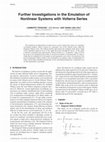
Journal of the Audio Engineering Society, 2015
The emulation of nonlinearities of audio devices can be achieved by means of a nonlinear convolut... more The emulation of nonlinearities of audio devices can be achieved by means of a nonlinear convolution method, which is based on a particular case of the Volterra series called the Diagonal Volterra series. The Volterra kernels characterize the nonlinear audio device being tested, dependent upon the level of the signal that passes through the device. In this paper a method is presented that approximates Volterra kernels in a "continuous" range of levels by means of an interpolation procedure of an achieved number of measurements. In order to obtain the best emulation for real signals several parameters were tested. An extension of the previous Diagonal Volterra model is also developed to an arbitrary order of nonlinearities in order to allow better emulation of harmonics of low and medium frequencies. A particular case for the experiments is presented.
The acoustic characteristics of the former "La Fenice" theater have been analyzed. Binaural measu... more The acoustic characteristics of the former "La Fenice" theater have been analyzed. Binaural measurements of the impulse responses were performed at a large number of measuring points within the hall. Following the recent ISO standard 3382 [1], many mono and binaural acoustical parameters were calculated from the impulse responses, such as reverberation time, clarity, center time, strength, initial time delay gap, interaural cross correlation, and others. Finally, Ando's preference maps were developed, taking into account two different kinds of musical signals. The measurements underlined the peculiar acoustical behavior of the theater, characterized by a greater initial decay of the reverberant tall and a subsequent reverberation that allowed a remarkable fusion of the sound and sustain to the musicians.
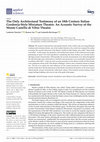
Applied Sciences
The acoustic characteristics and spatial features of the world’s only surviving Italianate Gordon... more The acoustic characteristics and spatial features of the world’s only surviving Italianate Gordonia-style miniature theatre, one of the smallest theatres in the world, have inspired the author to analyse the acoustic behaviour of the Monte Castello di Vibio theatre, also called “Teatro della Concordia”. In this paper, the geometric and architectural features of this historical and unique performing art space were first reproduced, considering that these features are essential factors affecting acoustic characteristics. Subsequently, the acoustic measurements were taken throughout the stall and inside some selected boxes, and their main parameters were acoustically characterised according to ISO 3382-1. Lastly, the main acoustic parameters of the Monte Castello di Vibio theatre were compared to those of the 1763 theatre in Bologna, which is also a miniature theatre of similar size. The aim is to explore the main influences on the acoustic parameters of miniature theatres, and the res...
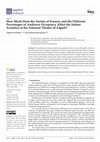
Applied Sciences
The performance of opera and the post-pandemic slow recovery of the public, who have been hesitan... more The performance of opera and the post-pandemic slow recovery of the public, who have been hesitant to return to frequent attendance of cultural venues, has inspired the authors to analyze the acoustic behavior of the National Theater of Zagreb, by reflecting five specific scenarios. Starting from acoustic measurements undertaken inside the National Theater of Zagreb without any scenery in place, this research study compares the main acoustic parameters simulated with the scenery of Tosca in three different acts. A numerical model was realized by reproducing the geometry and the architectural features of this historic performance arts space. Before the simulations, the absorption coefficients applied to the digital entities were calibrated with the values gathered from the recorded impulse responses. After the calibration process, the acoustic simulations were also carried out with the presence of an audience at two percentages of occupancy.
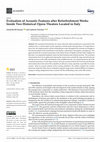
Acoustics, 2021
The acoustical characteristics of a room where the artistic performance is presented to the audie... more The acoustical characteristics of a room where the artistic performance is presented to the audience have a critical impact on the experience of both artists and spectators. It is important to know how the original aspects and the refurbishment works throughout the centuries are brought to the characterization of the sound field in such theatres, with positive and negative consequences. This paper presents the acoustical assessment of the Teatro Nuovo of Spoleto and the Teatro Alighieri of Ravenna, very important landmark centers for their historical and cultural activities. The acoustical characteristics have been gathered by placing the sound source on both the stage and orchestra pit, and the receivers in the stalls and balconies areas at different levels. It is of great interest to show the acoustical parameters of such Opera houses and some acoustical limits derived from intermediate interventions due to the need of the committees to allocate as many spectators as possible for ...

Building Acoustics, 2020
Soundfield diffuseness in rooms is considered a fundamental aspect of a high-quality room acousti... more Soundfield diffuseness in rooms is considered a fundamental aspect of a high-quality room acoustics. Since early studies by Hodgson up to more recent studies of Shtrepi and Embrechts, it was shown that high levels of sound diffuseness could guarantee blending of music, as well as spatial sound perception by listeners, and this could enhance the global indoor acoustic quality. Conversely, Italian-style Opera houses represent an important architectural place, in which the special features of the rich decorations, and the specific characteristics of the volume, give a unique atmosphere, including a peculiar psycho-acoustics impression. However, some geometric properties of the opera houses could influence the global acoustic perception. The shape of the marmorino wall on the stalls, as well as the parallelism of the lateral walls in the boxes, often causes a lack of spaciousness and sometimes in the worst cases provokes focalization. This phenomenon leads to design special devices that...
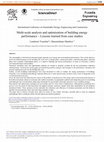
Procedia Engineering, 2015
The sustainability of the built environment largely depends on its energy and environmental perfo... more The sustainability of the built environment largely depends on its energy and environmental performances. The overall objective, across the different phases of the building life cycle such as design phase, construction phase, commissioning phase, operation phase and eventually refurbishment phase, is to improve building and system performances in terms of economics, comfort, environmental impact and durability. Numerical simulation tools and optimization methods are needed to properly evaluate all the key performance indicators simultaneously, unveiling the existing gaps and identifying possible synergies and strategies in the performance estimation and decision-making processes for the building life cycle. Further, several modelling methodologies have been developed in order to evaluate the energy performance of buildings. Generally, every modelling methodology responds effectively to some specific tasks, but there exists a lack of integration in the overall optimization process. Given the multi-scale and multi-objective nature of the problem of optimization of the energy and environmental performances of the built environment, subject to economic and comfort constraints, an appropriate synthesis and integration process in modelling methodologies has to be identified, addressing realistically the uncertainties inherently present in every modelling strategy. Data analysis and optimization techniques are successfully used in a wide variety of applications. Although these techniques have proven to be successful in both theoretical and applied domains, questions remains about their applicability for the problems introduced before. These questions involve primarily the robustness and efficiency of solutions procedures and the ability to identify relevant properties and to deal with large quantities of data. The paper aims to analyse critically these topics by means of case studies, showing a possible path to create an integrated methodology able to synthesize all the relevant aspects previously mentioned.

Acoustical Science and Technology, 2005
The definition and measurement of sound spatialisation have been strongly enhanced in last years,... more The definition and measurement of sound spatialisation have been strongly enhanced in last years, as nowadays spatial properties of sound propagation are considered quite important during design of auditoria. Besides, a proper description of spatiality is requested during virtual audio reproduction of sound quality in dedicated listening rooms for 3D reproduction purposes. Normally, only binaural measurements are performed, by means of a dummy head, even though international standards like ISO 3382 require measuring some spatial parameters (i.e. LE, LF, IACC). 3D impulse responses are rarely measured and utilised for sound reproduction. In this paper, an innovative procedure of measuring spatial sound characteristics is presented. The application of this new technique in virtual 3D sound reconstruction is emphasized. Furthermore, the methodology is compared with other techniques of 3D sound reproduction. Finally, the results of a wide campaign of measurements of spatial parameters among different auditoria all over the world, and conducted with the novel methodology, are compared with the results of standard binaural and 3D measurements. The possibility to enhance the spatial reproduction of sound quality in real spaces and the comprehensibility of spatial parameters is then considered and presented in different cases.

Energies, 2018
Stationary and dynamic heat and mass transfer analyses of building components are an essential pa... more Stationary and dynamic heat and mass transfer analyses of building components are an essential part of energy efficient design of new and retrofitted buildings. Generally, a single constant thermal conductivity value is assumed for each material layer in construction components. However, the variability of thermal conductivity may depend on many factors; temperature and moisture content are among the most relevant ones. A linear temperature dependence of thermal conductivity has been found experimentally for materials made of inorganic fibers such as rockwool or fiberglass, showing lower thermal conductivities at lower temperatures. On the contrary, a nonlinear temperature dependence has been found for foamed insulation materials like polyisocyanurate, with a significant deviation from linear behavior. For this reason, thermal conductivity assumptions used in thermal calculations of construction components and in whole-building performance simulations have to be critically questioned. This study aims to evaluate how temperature affects thermal conductivity of materials in building components such as exterior walls and flat roofs in different climate conditions. Therefore, experimental conductivities measured for four common insulation materials have been used as a basis to simulate the behavior of typical construction components in three different Italian climate conditions, corresponding to the cities of Turin, Rome, and Palermo.

Binaural impulse responses (BIRs) are measured to clarify the acoustical characteristics of the s... more Binaural impulse responses (BIRs) are measured to clarify the acoustical characteristics of the sound filed in concert halls and opera houses. Since BIRs indicates the transfer function of sound fields, an anechoic source convolved with the BIRs represents the signal which listeners hear in that sound field. To find out the acoustical characteristics of the original sound source, it is useful to calculate the autocorrelation function (ACF) because the parameters extracted from the ACF closely related to the subjective preference of listeners [1]. This study investigates the relationship between sound sources and sound fields by comparing the interaural crosscorrelation function (IACF) of BIRs and IACF of an anechoic source convolved with that BIRs. It can be said that the convolution and correlation are the most important calculative techniques in the room acoustics, and the convolution and correlation are identical under a certain condition. In this condition, IACC of an anechoic s...











Uploads
Papers by Lamberto Tronchin